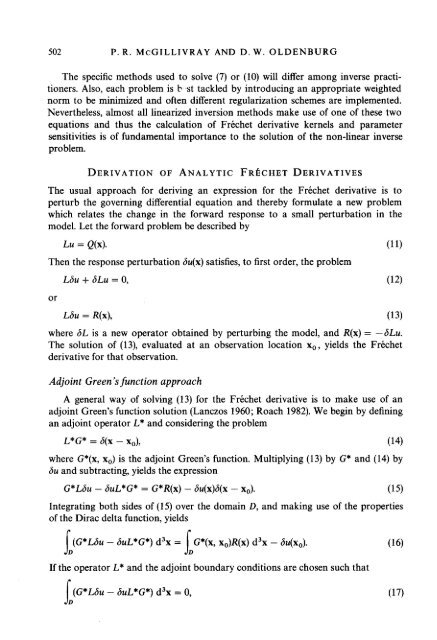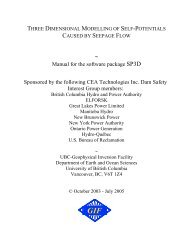METHODS FOR CALCULATING FRÃCHET DERIVATIVES AND ...
METHODS FOR CALCULATING FRÃCHET DERIVATIVES AND ...
METHODS FOR CALCULATING FRÃCHET DERIVATIVES AND ...
Create successful ePaper yourself
Turn your PDF publications into a flip-book with our unique Google optimized e-Paper software.
502 P. R. McGILLIVRAY <strong>AND</strong> D. W. OLDENBURGThe specific methods used to solve (7) or (10) will differ among inverse practitioners.Also, each problem is b st tackled by introducing an appropriate weightednorm to be minimized and often different regularization schemes are implemented.Nevertheless, almost all linearized inversion methods make use of one of these twoequations and thus the calculation of Fréchet derivative kernels and parametersensitivities is of fundamental importance to the solution of the non-linear inverseproblem.DERIVATION OF ANALYTIC FRÉCHET <strong>DERIVATIVES</strong>The usual approach for deriving an expression for the Fréchet derivative is toperturb the governing differential equation and thereby formulate a new problemwhich relates the change in the forward response to a small perturbation in themodel. Let the forward problem be described byLU = Q(x). (1 1)Then the response perturbation Su(x) satisfies, to first order, the problemorLSU + SLU = O, (12)LSU = R(x), (13)where SL is a new operator obtained by perturbing the model, and R(x) = -6Lu.The solution of (13), evaluated at an observation location xo, yields the Fréchetderivative for that observation.Adjoint Green’s function approachA general way of solving (13) for the Fréchet derivative is to make use of anadjoint Green’s function solution (Lanczos 1960; Roach 1982). We begin by definingan adjoint operator L* and considering the problemL*G* = S(X - xO), (14)where G*(x, xo) is the adjoint Green’s function. Multiplying (13) by G* and (14) bySu and subtracting, yields the expressionG*LSu - SuL*G* = G*R(x) - SU(X)S(X - ~ 0). (15)Integrating both sides of (15) over the domain D, and making use of the propertiesof the Dirac delta function, yieldss,S,(G*L6u - SuL*G*) d3x = G*(x, x,)R(x) d3x - Su(xo).(16)If the operator L* and the adjoint boundary conditions are chosen such that(G*LSu- SuL*G*) d3x = O,J,



